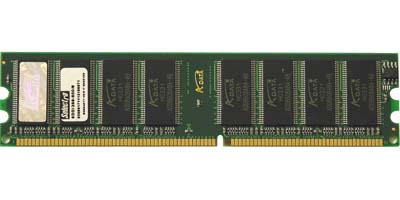There’s probably no one reading this that failed to miss Intel’s launch of the new Pentium 4 processors with 800 MHz bus. The new Pentium 4 processors with their quadruple pumped 200 MHz bus (4×200=800) demanded new chipsets and mainboards. Today, Intel’s chipsets Springdale (865) and Canterwood (875) is the only ones that are really widespread on the market. Mainboards as well as memory had to adopt to the new bus speed. DDR400 modules were nothing new at Intel’s launch of processors, but now when the new CPU bus demanded them to utilize the full bandwidth, they became increasingly popular.
There’s probably no one reading this that failed to miss Intel’s launch of the new Pentium 4 processors with 800 MHz bus. The new Pentium 4 processors with their quadruple pumped 200 MHz bus (4×200=800) demanded new chipsets and mainboards. Today, Intel’s chipsets Springdale (865) and Canterwood (875) is the only ones that are really widespread on the market. Mainboards as well as memory had to adopt to the new bus speed. DDR400 modules were nothing new at Intel’s launch of processors, but now when the new CPU bus demanded them to utilize the full bandwidth, they became increasingly popular.
Not many days passed by before we realized that our beloved memory modules were a big bottleneck, especially when it came to overclocking the new Pentium 4 systems. There were often no problems reaching 250 MHz bus speed with lower frequency processors which meant that our memory modules had to be of DDR-500 standard, to get along properly. For the extreme overclocker, we can often see bus speeds of over 300 MHz but then we suddenly talk about modules rated as DDR600. Today, when we we still have a bit to go until we see any DDR600 modules on the market, the question is if we have to wait for the DDR-II standard before those speeds can be achieved.
On the other hand, what really have showed up, is a heap of modules rated DDR500, also called PC4000, named after their theoretical bandwidth of 4000 Mb/s. There has also been launched a small amount of modules rated as PC4200, but not in any greater scale. To get a clear picture of today’s high performance modules we’ve chosen to make a comparison of a few of the bad boys on the market. We put four different modules from three different manufacturers with DDR500 specifications under our magnifying glass. But as if this isn’t enough, we also took a closer look at one of the modules that sports a brand new concept and without no doubt stands out of the crowd.
This review will more or less aim towards overclocking so for those who have no interest in that may surf along. If extreme performance modules with high bus speeds is in your interest, it could be worth your time to read on.
Before we move on with the different combatants, we shall take a closer look of what this quick escalation in memory speed brings along.
The market for memories has been very hot for some time and we have seen many attempts by producers to win the consumers affection. Early in 2003 aggressive timings were very popular and we saw a number of different labels for the same thing. Corsair came up with their LL series (Low Latency) and OCZ, for example, followed with their EL series (Enhanced Latency).
Both manufacturers did the same thing; optimized the memory modules for aggressive memory timings. Compared with other modules with less aggressive timings, this move improved the performance at the same clock frequencies. Read more about memory timings and the Low Latency concept in our Corsair TWINX512-3200LL review.
The reason for why we bring attention to this topic is that the market now seems to have reversed instead of improving, what memory timings are concerned. It is actually easier to explain than you think, basically it is probably all a matter of the age of the DDR-SDRAM technology. A conclusion one easily draw is that aggressive memory timings require higher quality from the memory modules. Even if you gain performance at the same clock frequencies with aggressive timings, you will lose stability at higher clock frequencies. It is simple; you can’t have your cake and eat it.
The aging DDR-SDRAM technology is one of the reasons why manufacturers need to invent new methods to increase the frequency on their modules. DDR-SDRAM technology is just not fit enough for these rates and it is not strange that the DDR-II technology most likely will be used on a number of products next year. We have already seen it enter the graphic card industry where the clock frequencies are far higher.
To achieve anything close to the FSB rates at 250-300 MHz in Pentium 4 systems with an overclocked system the manufacturer has to sacrifice a lot when it comes to memory timings. Corsairs LL specification at 2-2-2-6 timings sounds like heaven when we look at the specifications of the modules we are reviewing today. It is only a very few of these that actually work with 2-2-2-6 timings at any clock frequency.
Just like we said earlier you will lose a little performance if you run the modules at the same rates as modules with more aggressive timings can cope. However, you will regain this loss in performance if you overclock the FSB to 250+ MHz, as this makes it possible to run the memory modules at the same bus rate as the processor. This increases the bandwidth and avoid any possible latency error that occurs using asynchronous clock frequencies (i.e. processor bus and memory bus work at different clock frequencies).
The conclusion we get out of this is that these modules are aimed for overclockers using Intel Pentium 4 systems with 800 MHz FSB. The modules are optimized for this platform and do rarely work that well with AMD systems. For AMD we recommend Corsair TWINX512-3200LL.
Now, let’s continue with the reviews, and first is A-DATA.
| Type of memory: |
DDR-SDRAM
|
| Memory circuits: |
4.0 ns
|
| Memory cooling: |
–
|
| Memory bus (guaranteed): |
250 MHz (DDR500)
|
| Memory timings (guaranteed): |
3-4-4-8 timings @ DDR500, 2.5v
|
| Memory bandwidth (maximum): |
4.0 GB/s @ DDR500
|
| Amount of memory: |
256 MB
|
| Module construction: |
Single-sided, 8×32 MB
|
| Warranty : |
10 years
|
| Price: |
~€98 (Exchange rates)
|
A-DATA is a relatively unknown brand on the Swedish market. However, A-DATA’s products have actually sold quite well for a while in Sweden under the name Selectra. We do actually get some “Twinmos vibes” from these modules that have a very impending Spartan feeling. According to various reports, A-DATA’s modules are in accordance with Twinmos’ a wolf in sheep clothes, which performs far better than what the first impression may look like.
We will hopefully find out if this is true later on in the review.
As we mentioned earlier, the modules are not in any way dreadful in their appearance but the specifications are the better.
A-DATA PC4000 is, as the name implies, specified to a 250 MHz bus speed (DDR500) and this at 2.5v, which is impressive. Not many other modules can, according to their respective specifications, handle DDR500 speeds at 2.5v. The memory chips are marked as 4 ns circuits that reveal that it is “real” DDR500 chips, which should vouch for good performance.
The modules’ timings are conservative and far from the 2-2-2-6 that we discussed earlier; 3-4-4-8 are the specifications at DDR500 speed which is nothing to write home about.
But as you soon will see, it’s a bad thing within this class of memories.
These modules are “naked” and actually the only ones in the test that aren’t equipped with any kind of cooling for the memory circuits whatsoever. The reason for this is obviously to save production costs, but we had gladly seen some sort of heatsink since the memory chips develop pretty much heat at such high clock frequencies.
A-DATA manufactures a model of its PC4000 module that’s equipped with a heatspreader, but unfortunately, we have not had the opportunity to take a closer look at it to see what eventual differences there are between the two. Nevertheless, this is something we’ll do in short and we can already give you a little preview of how the new A-DATA modules look like.
Enough about upcoming products – now it is A-DATA’s present DDR500 modules we are reviewing and we’ll move on to price and availability.
| Price and availability |
A-DATA is as we mentioned earlier relatively unknown in around here, but that might change in the future. At present, A-DATA PC4000 is only available in a few Internet stores aimed at what A-DATA has become famous for; overclocking.
Overclockers.se and Kylning.com are two of the Swedish stores which supply these modules, and although the spread is not particularly great, there are at least two well-known retailers that have them in stock.
While the availability is somewhat halting, the price instead gives a really good impression. A-DATA is in the matter of price a very attractive choice and once again, we get some “Twinmos vibes”.
For slightly less than €100, you can get a 256 MB module of A-DATA’s DDR500, which is a very competitive price and clearly the cheapest in this comparison.
It’s still much dough for a memory module, but it’s clearly one of the cheapest alternatives among the PC4000 modules on the market today.
Since the modules we tested today is of different sizes, it is hard to make a fair price comparison. To facilitate this we have a MB/Euro value which shows a better picture of how the prices stand against each other.
|
256 MB A-DATA PC4000: MB/Euro
|
|
2,65 MB/Euro
|
How the MB/Euro value hold grounds in the competition is to be found out in the end of the review.
However, a good price is of no use if the product doesn’t perform well enough, which is why we sink our teeth in the overclocking tests of the A-DATA PC4000.
| Overclocking |
We’ll give you a complete list of the test system later in the review, but here is a brief description of parts that matters the most while overclocking:
ABIT IC7-MAX3
Intel Pentium 4 2.4 GHz air-cooled (800 Mhz FSB)
ATi Radeon 9600 256MB
A-DATA PC4000 was the only contribution in this comparison that wasn’t sold in a “Dual Channel Kit” with two modules in every package. Because of this, we took two randomly chosen modules and used them in our tests to be able to use the 875O chipset’s DualDDR support.
We were unfortunately working against the clock during this comparison, which made it impossible to burn in our memory modules for a longer period of time. With help from an ABIT IC7-MAX3, there was no risk that we wouldn’t be able to push the modules to their extremes since the card offers a maximum memory voltage of a whopping 3.2V.
Although that the system was completely air-cooled, the processor did not seem to be a bottle-neck. With that said, however, it’s still not impossible that we will do further tests on these modules with a more extreme system.
If anyone gets the impression that we try to hide bad results you may clam up – A-DATA PC4000 performs well. Actually very well!
It turned out that the modules had no problems at all with high voltages and at 3.2V, we managed to get the system stable at 280 MHz bus speed, DDR560. The system remained stable in e.g. the highly demanding 3DMark2001 and it really feels like “wolf in sheep clothes” is a very suitable name for these modules.
We could hardly get a much better start than this on this review, but now we quickly move on with the other competitors and hope for equally good results.
| Type of memory: |
DDR-SDRAM
|
| Memory circuits: |
4.3ns
|
| Memory cooling: |
Aluminium heatspreader
|
| Memory bus (guaranteed): |
250 MHz (DDR500)
|
| Memory timings (guaranteed): |
3-4-4-8 Timings @ DDR500, 2.75V
|
| Memory bandwidth (maximum): |
4.0 GB/s @ DDR500
|
| Amount of memory: |
2 x 512 MB
|
| Module construction : |
Double-sided, 8×32 MB
|
| Warranty: |
Lifetime
|
| Price: |
~ €500 (Exchange rates)
|
Corsair TWINX1024-4000 is one of the latest additions to Corsair’s TWINX series and there is not much that separates it from its predecessors on the outside, but looks may deceive.

The specifications for the Corsair TWINX1024-4000 are pretty much the same as the ones for A-DATA’s PC4000, which in no way is a bad thing. The memory’s specified timings at DDR500 speed are 3-4-48, thus identical to what we saw at A-DATA’s module, although the difference is that Corsair can only provide these settings at 2.75V.
That is as much as 0.25V higher than what A-DATA’s specifications conclude, which is noticeable but in the end not critical.
The design of the modules is more or less identical to the one that we are used to see from Corsair products. The heatspreaders covering both sides of the modules are made of aluminium and mounted against the memory chips with heat-conducting tape, making them relatively easy to remove.
Under the hood, we can see that Corsair has turned to Hynix to get the memory chips, which quite frankly aren’t “real” DDR500 chips. The chips are of model 4.3 ns and therefore “only” specified at DDR466 speeds. Whether this affects the modules overclocking potential or not remains to be seen.
| Price and availability |
Corsair has since long been a strong actor on the Swedish market and with this follows a great supply of its products in many stores. However, Corsair TWINX1024-4000 is a product that not every store acquires due to its somewhat limited customer range. Corsair XMS4000 is the company’s correspondence to A-DATA PC4000 that also is sold in a single package and might be more available for those who are interested.
Corsair TWINX1024-4000 is really not a lightweighter; this shows not only in amount of memory and performance but also in pricing. This is an extremely expensive memory kit and there certainly aren’t many people who would pay €500 for memory these days.
But if we go back to the single variant of the Corsair TWINX1024-4000, Corsair XMS4000 can be obtained for approximately €120 which is merely 25% dearer than A-DATA PC4000 and doesn’t conclude to wallet anorexia.
|
1024 MB Corsair TWINX1024-4000: MB/Euro
|
|
2.05 MB/Euro
|
The MB/Euro value for Corsair TWINX1024-4000 is, not entirely unexpected, worse than for A-DATA PC4000.
In other words, you can’t fairly compare the price of the Corsair TWINX1024-4000 to the price of the A-DATA PC4000, and even if Corsair is more expensive, the conclusion remains the same; the difference is not big enough to justify the high price.
| Overclocking |
We briefly went through the test system on the former page, thus we go straight onto the tests.
What we first noticed with Corsair TWINX1024-4000 was its unwillingness to co-operate at really high voltages. When we fed the modules with 3.2V, the system became unstable, even at 250 MHz FSB, and it clearly showed that we couldn’t give it how much voltage we wanted in this regard. At last, it showed that we could not exceed 2.85V if we were interested in retaining optimal stability.
Despite the relatively low voltage, there was no problem pushing the modules far by their specifications and finally we landed at a 270 MHz bus speed, DDR540.
The results were not as impressive as A-DATA PC4000’s, but considering the differences in terms of voltage, this is also a very good result.
As you know, we have been under certain time pressure when writing this review and we intend to do a follow-up with more extreme tests of the memory modules. Not only with a better test rig, but also with orderly burned-in memory modules etc.
But before that, let’s move on to the remaining competitors participating in this review and next man for shaving is someone we haven’t seen earlier in the barber shop.
| Type of memory: |
DDR-SDRAM
|
| Memory circuits: |
4.0 ns
|
| Memory cooling: |
Aluminium heatspreader with activity LEDs
|
| Memory bus (guaranteed): |
250 MHz (DDR500)
|
| Memory timings (guaranteed): |
3-4-4-8 Timings @ DDR500, 2.75v
|
| Memory bandwidth (maximum): |
4.0GB/s @ DDR500
|
| Amount of memory: |
2×256 MB
|
| Module construction: |
Double sided, 8×32 MB
|
| Warranty: |
Lifetime
|
| Price: |
Probably somewhere around €550 (exchange rates)
|
The giant of the review is without a doubt the Corsair TWINX1024-4000 Pro and you can with all rights be amazed over the company’s new addition in its line of products. Corsair TWINX1024-4000 Pro was launched in the beginning of the week and is Corsair’s flagship number one. The Pro series has several family members which will be launched in the near future and all are equally equipped with the sensational heatspreader displayed in the images.
This heatspreader is the big news with the Pro series, which doesn’t differ much from its predecessor in other ways. Let’s have a look.
The specifications of the memory are identical to Corsair TWINX1024-4000 when it comes to speed and memory timings. The real difference is the memory’s heatspreader.
You can rightfully wonder in what way you can revolutionize a memory heatsink and the answer is not entirely obvious.
First of all, Corsair has made its new XMS heatspreader more effective by increasing the contact area to the memory chips by up to as much as 100%. To succeed, it has mounted the heatspreader in a thermic way which should vouch for optimal heat transfer from the memory chips to the heatspreader.
Even if it might be the most useful change, it is not the most sensational. The feature that instead gets the most attention is the 18 activity LEDs that are integrated in the upper part of the heatspreader.
These LEDs indicates what level of memory activity is in the computer and might be seen as a physical equivalence to the performance tab in the regular task manager of Windows XP. When the system’s memory usage increases and decreases, this can be seen directly on the memory module which is a completely unique feature. The function is simple; the more LEDs lit with high-intensity light, the higher memory usage.
Of course, the necessity for this quality might be discussed deeply, but it has at least a very high status factor on LAN parties or similar events.
 |
Unfortunately, the new modules’ heatspreader is impossible to remove without risking damages to the module itself and especially its activity LEDs. This makes it impossible for us to say what kind of memory chips that is hidden under there and it also complicates eventual modifications for the consumer.
Except for the new heatspreader, this appears to be a copy of the Corsair TWINX1024-4000, albeit we’ll still test the two modules side-by-side to find out whether we can find any differences, especially in ways overclocking potential.
| Price and availability |
Corsair has, as mentioned, a wide customer range in Sweden and is sold by several Internet stores which attests for good availability even for Corsair TWINX1024-4000 Pro. This far, the modules have not appeared in stores yet, since they’re is terribly fresh. Sadly, this makes it hard to have accurate pricing information on the Pro modules from Corsair, but we can guarantee that Corsair TWINX1024-4000 Pro will leave a big hole in your wallet. Corsair TWINX1024-4000 costs about €500 and it’s no long shot to say that Corsair TWINX1024-4000 Pro will end up on the same side of the €500 border.
We can’t say too much about the costs of the new heatspreader, but we’re afraid that it will affect the consumer noticeably.
We are not complete strangers to a price addition of maybe €10 per 256 MB module, but chances are that the price difference will be much bigger.
Without definitive price information, it’s tremendously difficult to set a MB/Euro value on Corsair TWINX1024-4000 Pro, but if we estimate the cost to somewhere around €550, we get a value of 1.8 MB/Euro. Nevertheless, this information must be taken with a big bowl of salt, since it’s only speculations from our side.
|
1024 MB Corsair TWINX1024-4000 Pro: MB/Euro
|
|
1.9 MB/Euro
|
| Overclocking |
We didn’t really know what kind of results to expect from Corsair TWINX1024-4000 Pro in our overclocking tests. Would the differences be minimal compared to Corsair TWINX1024-4000 or perhaps the new heatspreader would make a bigger difference than what you may think?
First of all, it showed that Corsair TWINX1024-4000 Pro also had some problems with higher voltages and we concluded at 2.9V for optimal stability. Higher voltages only gave negative results.
It actually showed that Corsair TWINX1024-4000 Pro gave a little better overclocking potential than its predecessor, as we managed to push the module up to 274 MHz bus speed, DDR548; a results that puts the module between Corsair TWINX1024-4000 and A-DATA PC4000. Not bad.
Also, we wait with excitement for slightly more detailed overclocking tests to see if burned-in memory modules might give higher clock frequencies.
Now, it’s time for the last competitor in this comparison.
| Type: |
DDR-SDRAM
|
| Circuits: |
4.0ns
|
| Cooling: |
Copper heatspreader
|
| Bus speed (guaranteed): |
250MHz (DDR500)
|
| Timings (guaranteed): |
2.5-4-4-7 Timings @ DDR500, 2.8v
|
| Bandwidth (guaranteed): |
4.0GB/s @ DDR500
|
| Size: |
2 x 256MB
|
| Module design : |
double sided, 8x32MB
|
| Guarantee: |
Lifetime (10 years from Swe. retailer)
|
| Price: |
~ 2790 SEK
|
As one would expect of us, we have also acquired the OCZ flagship of the memory market. Since our tests are based upon a Dual Channel DDR-system, we used their Dual-Channel version of the OCZ EL PC4000 GOLD.
OCZ have since the age of SDRAM equipped their modules with heat spreaders. As such it comes to no real surprise that this high-end module comes equipped with a real pair of good heat spreaders. The OCZ EL PC4000 Dual Channel Gold has, as its name implies, golden coloured heat spreaders. Of course the heat spreaders are not made of real gold, but rather the more preferred copper. Copper has a better heat absorbing ability than Aluminium and is thus, at least theoretically, a better choice. On the other hand it is not only more expensive but also weighs a lot more. Even if the OCZ heat spreader isn’t the most innovative, it is definitively the one that feels the most effective. This feeling is largely caused by its heavy weight.
Unfortunately the heat spreader on the OCZ module is rather difficult to remove, and since we didn’t want to damage the modules we did not remove them. Thus we did not get a look at which memory chipset was used but OCZ claims it to be a 4.0ns type.
OCZ EL PC4000 Dual Channel GOLD bears the prefix ‘EL’, which should mean low and aggressive memory timings. This is mildly said an exaggeration, considering they’ve specified the timings to 2, 5-4-4-7. On the other hand this is the best specifications we can find on the modules in this test, but yet again, at 2.8V they also use the highest current.
| Price and accessibility |
OCZ is a rather well known manufacturer here in
The price on the OCZ EL PC4000 Dual-Channel GOLD 512MB (2*256MB) is barely 280 Euro, and even if we haven’t found the modules in single packages, we are approximating the 256MB module (1*256MB) going for about 130-140 Euro in store.
Then how does the OCZ module compare when it comes to MB/Euro?
|
512MB OCZ EL PC4000 Dual Channel Gold: MB/Euro
|
|
1,8 MB/Euro
|
OCZ EL PC4000 Dual-Channel GOLD shows the worst MB/Euro value in the comparison, and compared to the best value in the test, 2,9 by the A-DATA PC4000 it’s a difference of a whole 61% to A-DATA’s advantage!
| Overclocking |
OCZ specifies in their specifications that their memory modules warranty is worthy up to 3.0v memory-current, thanks to their EVP-technology, Extended Voltage Protection. Exactly how this works we cannot say but this is what OCZ themselves has to say.
“OCZ Extended Voltage Protection® circuit protection allows modules to handle higher voltages through a novel voltage protection circuit. OCZ EVP® protected modules tolerate VDIMM voltages of up to 3.0 volts +/- 5% and are covered by the OCZ lifetime warranty if overvolted within EVP® tolerances.”
Imagine then our surprise as our test product refused to work at higher levels than 2.8v. This was exactly the same stability-problem as we saw on the Corsair modules, and was something we were not prepared for. We do not know yet if we have acquired a touchy kit or if further testing had helped, but this is something we are determined to look into more, but until we have done that we can give you the results we made at 2.8v memory voltage.
While maintaining full stability we managed to get the modules up to the very respectable 270 MHz or DDR540. This is as far as we managed to get our Corsair TWINX1024-4000 and definitely nothing to be ashamed about.
Before we move on to our performance tests, we’ll look more into the test-system.
|
Hardware
|
|
| CPU: |
Intel Pentium 4 2.4 GHz (800 MHz)
|
| Mainboard: |
ABIT IC7-MAX3
|
|
RAM:
|
A-DATA PC4000 (2 x 256MB) |
|
Graphics:
|
MediaMax Radeon 9600Pro 256MB
|
|
HDD:
|
46.1GB IBM 75GXP
|
|
Software
|
|
| Operating system : |
Windows XP Professional
|
| Drivers: |
ATI Catalyst 3.7
DirectX 9.0 |
|
Software :
|
3Dmark2001 SE Build 330
SiSoft Sandra 2003 |
This review/comparison is aimed for the real enthusiasts and overclocker who wants to push your system to the maximum. Therefore we have chosen to not run many tests, because the result in many programs depends on much more than just the memory.
We will instead focus on the overclocking of the memory modules and takes a few performance tests to cover everything.
If any reader wants to see more performance tests it will not be impossible, we are already planning more memory reviews.
To evaluate the memories functionality, performance and overclocking potential we’ve choose to use SiSoft Sandra and 3DMark2001. The last one mentioned is only used to test the stability since the test computer only was equipped with a Radeon 9600 (which makes the graphics card the outstanding limiting factor in the test, and not the performance differences between different memory settings).
First of all we test the memories in 2.8 volts with a FSB at 250 MHz (DDR500) and let the memories SPD-chip handle the timing-settings on their own. The SPD on all four memory modules should work in the JDEC 3-8-4-4 according to the manufacturers. Although both Corsair’s modules worked in 3-7-4-4 instead and as we will tell more about later, it seems like the memories seems to work absolutely best with this setting.
|
|||||||||||||||||||||||||||||||||||||||||||||||||||||||||||||||||||||||||||||||||||||||||||||||||||||||||||||||||||||||||||||||||||||||||||||||||||||||
As one could suspect, the Corsair’s modules performed a little bit better in the first tests due to it’s lower TRAS-timing, this is especially visible in the unbuffered test. It’s not at all a day-and-night difference we talk about and we can guarantee that you can’t “feel” any difference in any applications or games. But we can not deny the advantage (how small it even is).
The first tests might not be the most interesting ones we can show you. The real potential of these modules won’t show until we start the overclock of our fine PC4000-memories.
|
|||||||||||||||||||||||||||||||||||||||||||||||||||||||||||||||||||||||||||||||||||||||||||||||||||||||||||||||||||||||||||||||||||||||||||||||||||||||
First of all we have to comment which settings are used once again.
- A-DATA PC4000: 3.2v, 2.5-7-4-4, 280 (560) MHz
- Corsair TWINX1024-4000: 2.8v, 3-7-4-4, 270 (540) MHZ
- Corsair TWINX1024-4000 Pro: 2.8v, 3-7-4-4, 274 (548) MHz
- OCZ EL PC4000 Gold: 2.8v, 3-8-4-4, 270 (540) MHZ
It looks like there is no doubt about that the A-DATA memory should perform best in our tests. But strangely it only had a (very marginal) advantage in our buffered tests while the Corsairs made a grand slam in the unbuffered tests. The performance differences in the last mentioned tests are hard to explain. We made the tests several times and these results repeated themselves each time so we really don’t know what we should think. We tested all configurations several times and confirmed the clock frequencies/timings in both BIOS and CPUZ in Windows etc. Despite this the test system again and again gave us these results. Eventually we it might have to do with a bug where some component shows the wrong memory settings which can give, what it looks like, inexplicable performance differences. The memory which performs worst is the OCZ though, no doubt about that.
To appoint a definite winner between A-DATA and Corsair is really hard since the performance tests talks against the real overclocking quite frankly.
As a funny footnote we can say that we actually succeeded in booting the A-DATA memory in almost DDR600 (i.e. PC4800).
To think about when we see all test results is that it really demands a CPU with great overclocking ability to be able to get any use at all of these memories. For you who don’t overclock it’s even unnecessary to get this type of memory. It would probably be a smarter idea to get a less clocked memory but tolerates more aggressive timings for example.
PC4000, also known as DDR500, is a memory standard which spreads more and more on the market. Although, the fact that it still are quite few users who can make use of these high performance modules remains. There are several points which must coincide if you as a consumer shall make any use of the specified speeds of these modules at all, even more if you are thinking of pressing them to the utmost.
First and foremost you have to be an owner of a Pentium 4-system. AMD-owners don’t even have to think about it since FSB speeds around 250MHz+ on these systems are almost as common as Swedish medals in basketball championships. Apart from that you must be an owner of a Pentium 4-system with a FSB of 800 MHz you must also be prepared to overclock your system. You can’t just use any CPU either since you must have such a low multiplier so you really can reach FSB speeds over 250 MHz. As for today it is the Intel Pentium 4 2.4 GHz which applies and that was also what we used in our test system.
If you are one of them who fits in this description? Then you have several alternatives to chose between and we’ve looked closed on four of them.
The two most interesting parts of these high performance modules are the overclocking potential and the price. To get an easier comparison between the different modules we’ve made a small table with this information.
| Memory module: |
MB/€
|
Maximal OC (by SPD)
|
| A-DATA PC4000 |
2,65
|
280 MHz (DDR560)
|
| Corsair TWINX1024-4000 |
2,05
|
270 MHz (DDR540)
|
| Corsair TWINX1024-4000 Pro |
1,9*
|
274 MHz (DDR548)
|
| OCZ EL PC4000 Dual Channel Gold |
1,8
|
270 MHz (DDR540)
|
A-DATA has turned this show completely up and down with a very anonymous appearance, both the design and the price, but with an impressive performance under its skin. It seems like A-DATA don’t just have the clearly cheapest modules in this test, but also the ones with the highest overclocking potential.
There are some questions left about the overclocking and performance results of the difference modules though, and we want to solve them. We are going to follow up this review with another round which will aim on more extreme overclocking and maybe even more performance tests, if the readers wish so.
But round ones winner is without doubt the A-DATA PC4000 module which made a deep impression in the testlab.
With Corsair’s TWINX-kit it shows that they still are one of the leading memory manufacturers on the market and the performance of its modules is as usual very good. Corsair’s Pro-series is an innovative commitment we really appreciates in an otherwise pretty predictable market. How usable the new Pro-heatspreader is, is up to everyone to decide, but the integrated LEDs in the heatspreader should work as a way to troubleshoot and to impress your friends with. Corsair TWINX1024-4000 Pro also had a little bit better overclocking potential then its forerunner, but if this depends on its better memory chip or a more effective heatspreader is best left unsaid.
We are anxiously waiting for the price of the Corsair Pro-series and hopefully it won’t be that high.
OCZ show that it once again makes very competent memory modules for the High-end market and even if OCZ EL PC4000 Dual Channel Gold wasn’t a test winner this time it made a stable impression. The only thing we were a bit enraged about was the modules inability to handle memory voltage over 2.8v which we hopefully have solved before round 2.
Until now it’s as already mentioned without doubt A-DATA PC4000 we rate highest here at NH and with that it is awarded with the “Editor’s Choice” award. We also think that Corsair deserves our “Innovation Award” for their new Pro-series of memory modules.
Many probably thought that innovative thinking didn’t had a spot on the memory market but seemingly that is the case.
 A-DATA PC4000 |
 Corsair TWINX1024-4000 Pro |
|
|
||||
|
|
As a final point in this review we can tell all AMD-owners and you who aren’t serious overclockers that you should commit on getting memory modules marked PC3200/PC3500 which can give better performance with more aggressive timings. A perfect choice in this segment is e.g. Corsair TWINX512-3200LL which we’ve reviewed earlier here at NH.
































